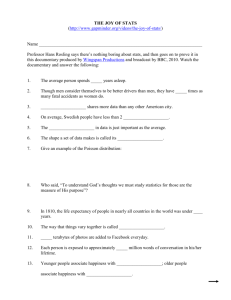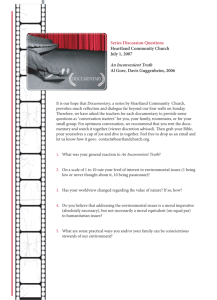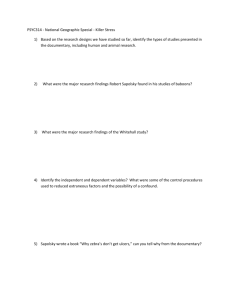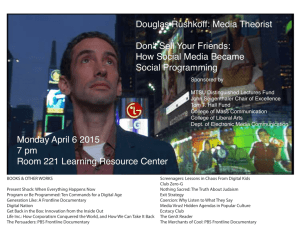Assignment 4 - UCSC Directory of individual web sites
advertisement
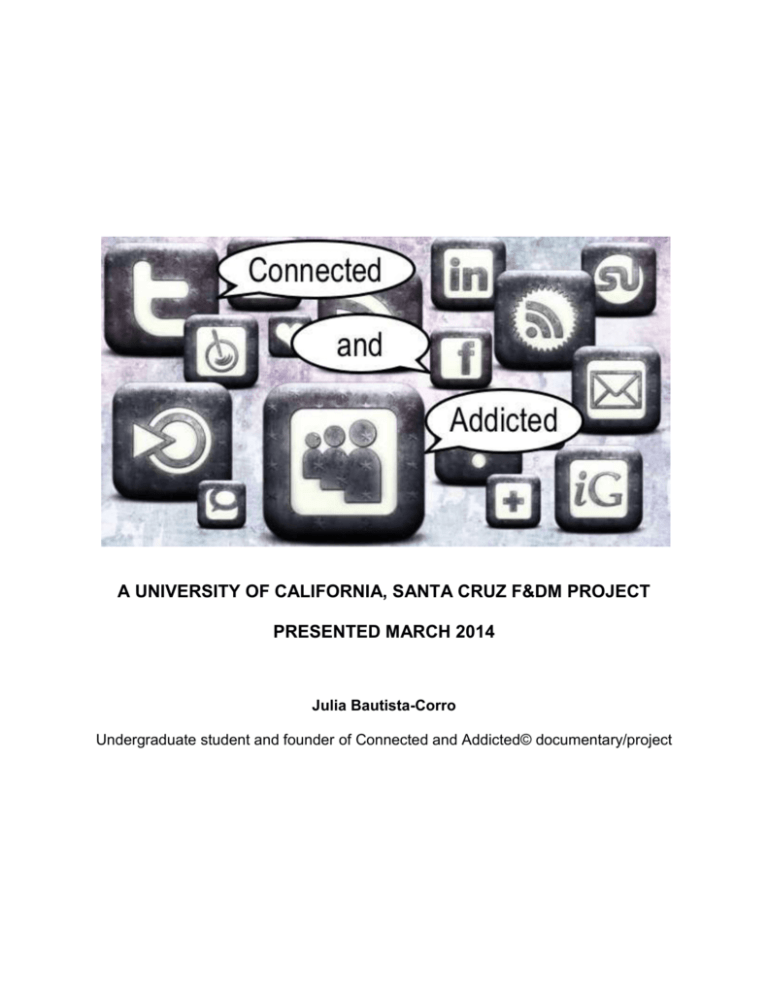
A UNIVERSITY OF CALIFORNIA, SANTA CRUZ F&DM PROJECT PRESENTED MARCH 2014 Julia Bautista-Corro Undergraduate student and founder of Connected and Addicted© documentary/project PROJECT Connected and Addicted©: A documentary of the new generation of adolescents and their addiction to smart phones and social networks. OVERVIEW Connected and Addicted© is a documentary being developed that examines two high school’s and their students extreme dependency on their smart phones and social network accounts. Not only will the documentary show statistics on high school student dependency on their smart phones, but it will also go into the regular, everyday lives of many different adolescents. The overall goal for this documentary is to reach a reason as to why adolescents from age 13 to 18 seem to be immersed in an imaginary world that is the internet. The intended audience for this documentary is high school students, college students, families, and anyone who has a smart phone. The reason for my intended audience is for anyone who has a smart phone to receive a sort of wake up call as to their addiction to their smart phones and how much that is eliminating them from interacting with people in the real world. With this documentary, I hope to travel to many different high schools to give students a different perspective to their addiction to smart phones and social networks. Not only do I want to offer this documentary to students as a sort of wake up call, but also I ultimately want to give them options to express their creative outlets elsewhere than on the internet and for them to create real relationships rather than be dependent on the internet to do all the work for them. RESEARCH I plan to research some of Sherry Turkle's own research that influenced this documentary altogether. I also hope to interview with Sherry Turkle about her work. I also plan to research the two public high schools I will be observing throughout my time with this documentary. The two public high schools’ I will be observing are both from my hometown in Napa, California: Napa High School and Vintage High School. Both schools have a different mix of students and cultures that will offer a variety of possibilities for my documentary. HISTORY/LONG DESCRIPTION I had become interested in making a documentary like this when I first watched Sherry Turkle’s “Connected, but alone?” (2012) video in one of my sociology classes when we were discussing media and immersion. Sherry Turkle studies how our devices and online personas are redefining human connection and communication—and asks us to think deeply about the new kinds of connection we want to have. Sherry Turkle studies how technology is shaping our modern relationships: with other, with ourselves, with it. This documentary is sort of like a spin-off and a closer look towards Sherry Turkle’s video. I wanted to know as to WHY adolescents preferred to spend hours on YouTube rather than actual go out. I wanted to know as to WHY adolescents cannot seem to put down their phones for a minute and actually go out and develop relationships with their peers. I wanted to know as to WHY many schools have started to recommend their students to bring laptops and iPad’s to school in order for them to complete their work. Are high schools slowly figuring out that the only way to get an adolescents to pay attention to assignments and homework is to immerse their students even more towards their computers and phones? I was in utter shock when my little sister came home on her first day of high school and told my parents that she needed to obtain a laptop because her teachers have told her that it was required. I was completely confused because I knew that throughout my high school career, I never really needed a laptop of my own. I had a desktop computer at home that I would use for my school assignments but I never really desperately needed a laptop up until I was going to leave for college. During 2005, online social network sites like MySpace and Facebook became common destinations for young people in the United States (boyd 2007). Throughout the country, young people were logging in, creating elaborate profiles, publicly articulating their relationships with other participants, and writing extensive comments back and forth. By early 2006, many considered participation on the key social network site, MySpace, essential to being seen as cool at school (boyd 2007). While not all teens are members of social network sites, these sites developed significant cultural resonance amongst American teens in a short period of time. Although the popularity of MySpace has since faded, many other social networks like Facebook, Twitter, Instagram, Google+, etc. have since flourished and have continued to be an important part of teen social life. The rapid adoption of social network sites by teenagers in the United States and in many other countries around the world has raised a variety of questions. Why do teenagers flock to these sites? What are they expressing on them and why? How do these sites fit into their lives? What are they learning from their participation? How long do they spend on these sites and how often? Why do they post what they post? Are these online activities like face-to-face friendships—or are they different? The ultimate goal for this documentary is to answer these questions and more, and explore their implications for youth identities. While many of these particular sites come and go, the continuing dependency towards smart phones and how youth engage through social network sites today provides long-lasting insights into identity formation, status negotiation, and peer-to-peer sociality. Computer networks are inherently social networks, linking people, organizations, and knowledge (Wellman 2001). The Internet increases people’s social capital, increasing contact with friends and relatives who live nearby and far away. I am completely for the development and advancement that technology has undergone so far, but I do not believe the internet should be a way for people to identify themselves. People should be able to identify themselves through what they have other than what their smart phones and social networks may tell them. PRODUCTION PLAN REQUIREMENTS (RESOURCES NEEDED) Video camera Lighting (+person) Sound (+person) Permission to film and interview students from both high school’s Editing program (+person) Computer MILESTONES (ROUGHLY ACCURATE) 1. Develop a team (March 2014) 2. Introduce documentary project to F&DM department and gain approval (March 2014) 3. Present documentary project to the two high school’s I hope to observe and gain approval (April 2014) 4. Have both school’s send out a form of consent to students families explaining the project and obtain the approval of some students families to observe their student (May 2014) 5. Start documentary with getting solo shots of both schools (June 2014) 6. Interview two students from every class (freshman, sophomore, junior, senior) (July 2014) 7. Follow the lives of students throughout the year (August 2014-June 2015) 8. Finish filming (July 2015) 9. Edit the film (July 2015-December 2015) 10. Finish the documentary and begin presenting it throughout public school’s (March 2016) WORKS CITED boyd, danah. (2007) “Why Youth (Heart) Social Network Sites: The Role of Networked Publics in Teenage Social Life.” MacArthur Foundation Series on Digital Learning – Youth, Identity, and Digital Media Volume (ed. David Buckingham). Cambridge, MA: MIT Press. Connected, but Alone? Perf. Sherry Turkle. TED.com. TED, Apr. 2012. Web. May 2013. Wellman, Barry. "Computer Networks As Social Networks." (n.d.): n. pag. 14 Sept. 2001. Web. 20 Jan. 2014.
